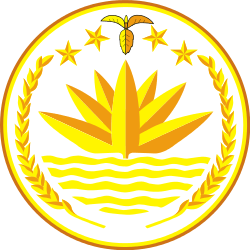Khasi people
The Khasi people are an indigenous ethnic group of Meghalaya in north-eastern India with a significant population in the bordering state of Assam, and in certain parts of Bangladesh. The Khasi people form the majority of the population of the eastern part of Meghalaya, and is the state's largest community, with around 48% of the population of Meghalaya. They are the only Mon-Khmer speaking people in South Asia. A cultural tradition of the Khasi people is that they follow the matrilineal system of descent and inheritance. Under the Constitution of India, the Khasis have been granted the status of Scheduled Tribe.
_Biplob_Rahman.jpg) Khasi men near Moulvibazar, Bangladesh | |
| Total population | |
|---|---|
| 1,512,831 | |
| Regions with significant populations | |
| 1,427,711[1] | |
| Meghalaya | 1,411,775[1] |
| Assam | 15,936[1] |
| 85,120 | |
| Languages | |
| Khasi | |
| Religion | |
| Christianity (85%) • Ka Niam Khasi (13%) Islam (2%) | |
| Related ethnic groups | |
| Khmers, Palaungs, Was, Kinh and other Mon–Khmers | |
History
Khasi mythology
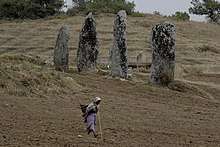
Khasi mythology traces the tribe's original abode to 'Ki Hynñiewtrep ("The Seven Huts").[2] According to the Khasi mythology, U Blei Trai Kynrad (God, the Lord Master) had originally distributed the human race into 16 heavenly families (Khadhynriew Trep).[3] However, seven out of these 16 families were stuck on earth while the other 9 are stuck in heaven. According to the myth, a heavenly ladder resting on the sacred Lum Sohpetbneng Peak (located in the present-day Ri-Bhoi district) enabled people to go freely and frequently to heaven whenever they pleased until one day they were tricked into cutting a divine tree which was situated at Lum Diengiei Peak (also in present-day Ri-Bhoi district), a grave error which prevented them access to the heavens forever. This myth is often seen as a metaphor of how nature and trees, in particular, are the manifestation of the divine on Earth and destroying nature and trees means severing our ties with the Divine. Like the Japanese, the Khasis use the rooster as a symbol because they believe that it was he who aroused God and also humbly paved and cleared the path for God to create the Universe at the beginning of time. The rooster is the symbol of morning marking a new beginning and a new sunrise.
Language
The Khasi language is classified as part of the Austroasiatic language family. According to Peter Wilhelm Schmidt , the Khasi people are related to the Mon-Khmer people of South East Asia. Multiple types of research indicate that the Austroasiatic populations in India are derived from migrations from Southeast Asia during the Holocene period. Many of the words are similar to other Austroasiatic languages such as Palaung and Khmer language:
- Tiger- Khla (Both Khasi &Khmer).
- To fly- Her in [Khasi], haer in [Khmer]
- Belly- kpoh in [khasi], poh in [khmer], bung in Vietnamese.
- New- 'Thymme or thymmai' in Khasi , thmei or thmai in [Khmer], moi in Vietnamese
- Year- Snem in [Khasi] , chnem in [khmer], nam in Vietnamese
- Far- jngai in [Khasi], chngay in [Khmer]
- Leaf- Sla or 'la in [khasi] , slaek in [khmer], la in [Vietnamese language]
- Crab- tham in [khasi] , ktam in[khmer]
- Fingers- preamti in[only pnar dialect (khasi sub-tribe)] , mreamdai in[khmer ], ngon tay in Vietnamese.
- Toes- preamjat in [only pnar dialect (khasi sub-tribe)],mreamcheung in [khmer], ngon chan in Vietnamese.
- Children- Khun,khon,kon in [khasi], kaun, kon, in [khmer], con in [vietnamese]
- Birds- sim in {khasi}, 'chim in {vietnamese}
- Eyes- khmat or 'mat in {khasi}, mat in {vietnamese}
- Fish- 'kha in [Khasi] , 'Ca' in [Vietnamese]
- Mother - mei in [khasi] , mẹ in [vietnamese], mea also in [Thai a kra-dai language family]
- Lion- 'sing' in [Khasi] , singto in [Thai a kra-dai language family]
- Rice- Khaw in [Khasi] and Thai also 'Khaw', Gao in Vietnamese.
There are also similar to those in Sino-Tibetan languages, such as nga meaning "I," which is the same in Tibetan, Burmese, and Old Chinese as it is in Khasi. Traces of connections with the Kachin tribe of North Burma have also been in the Khasis. The Khasi people also have their own word for the Himalayan mountains which is "Ki Lum Mankashang" which means that at one point in time, they did cross the mighty mountains. Therefore, all these records and their present culture, features, and language strongly show that they also have a strong Tibeto-Himalayan- Burman influence. The word "Khas" means hills and they have always been people of cold and hilly regions and have never been connected to the plains or arid regions. This nature-loving tribe calls the wettest place on Earth their home. The village of Mawsynram in Meghalaya receives 467 inches of rain per year.
Primarily an oral language, they had no script of their own, they used the Bengali script until the arrival of the Welsh missionaries. Particularly significant in this regard was a Welsh evangelist, Thomas Jones, who had transcribed the Khasi language into the Roman Script.
Modern times
The Khasis first came in contact with the British in 1823, after the latter captured Assam. The area inhabited by the Khasis became a part of the Assam province after the Khasi Hill States (which numbered to about 25 kingdoms) entered into a subsidiary alliance with the British.
The main crops produced by the Khasi people are betel leaf, areca nut, oranges, local Khasi rice and vegetables.
Geographical distribution and sub-groups
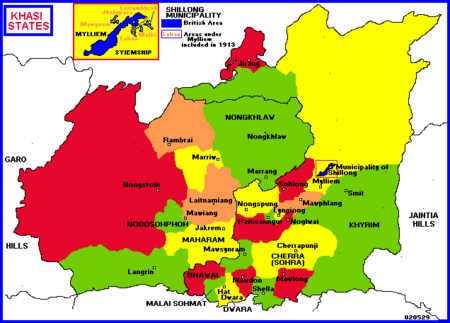
According to the 2011 Census of India, over 1.41 million Khasi lived in Meghalaya in the districts of East Khasi Hills, West Khasi Hills, South West Khasi Hills, Ri-Bhoi, West Jaintia Hills and East Jaintia Hills. In Assam, their population reached 35,000. It is generally considered by many Khasi sociologists that the Khasi Tribe consist of seven sub-tribes, hence the title 'Children of the Seven Huts': Khynriam, Pnar, Bhoi, War, Maram, Lyngngam and Diko. The Khynriam (or Nongphlang) inhabit the uplands of the East Khasi Hills District; the Pnar or Synteng live in the uplands of the Jaintia Hills. The Bhoi live in the lower hills to the north and north-east of the Khasi Hills. and Jaintia Hills towards the Brahmaputra valley, a vast area now under Ri Bhoi District. The War, usually divided into War-Jaintia and War-Khynriam in the south of the Khasi Hills, live on the steep southern slopes leading to Bangladesh. The Maram inhabit the uplands of the central parts of West Khasi Hills Districts. The Lyngngam people who inhabit the western parts of the West Khasi Hills bordering the Garo Hills display linguistic and cultural characteristics which show influences from both the Khasis to their east and the Garo people to the west. The last sub-group completing the "seven huts", are the Diko, an extinct group who once inhabited the lowlands of the West Khasi Hills.
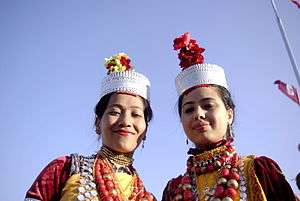
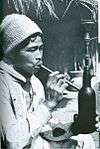
Dress
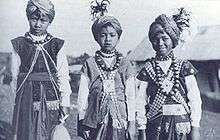
The traditional Khasi male dress is a Jymphong, a longish sleeveless coat without collar, fastened by thongs in front. Nowadays, most male Khasis have adopted western attire. On ceremonial occasions they appear in a Jymphong and sarong with an ornamental waist-band and they may also wear a turban.
The traditional Khasi female dress is called the Jainsem or Dhara, both of which are rather elaborate with several pieces of cloth, giving the body a cylindrical shape. On ceremonial occasions, they may wear a crown of silver or gold. A spike or peak is fixed to the back of the crown, corresponding to the feathers worn by the menfolk. The Jainsem consists of two pieces of material fastened at each shoulder. The "Dhara" consists of a single piece of material also fastened at each shoulder.
Marriage
The Khasis are, for the most part, monogamous. Their social organisation does not favour other forms of marriage; therefore, deviation from this norm is quite rare. Young men and women are permitted considerable freedom in the choice of mates. Potential marriage partners are likely to have been acquainted before betrothal. Once a man has selected his desired spouse, he reports his choice to his parents. They then secure the services of a mediator to make the arrangements with the woman's family (provided that the man's clan agree with his choice). The parents of the woman ascertain her wishes and if she agrees to the arrangement her parents check to make certain that the man to be wed is not a member of their clan (since Khasi clans are exogamous, marital partners may not be from the same clan). If this is satisfactory then a wedding date is set.
Divorce (with causes ranging from incompatibility to lack of offspring) is easily obtainable. This ceremony traditionally consists of the husband handing the wife 5 cowries or paisa which the wife then hands back to her husband along with 5 of her own. The husband then throws these away or gives them to a village elder who throws them away. Present-day Khasis divorce through the Indian legal system.
The type of marriage is the determining factor in the marital residence. In short, post marital residence for a married man when an heiress (known as Ka Khadduh) is involved must be matrilocal (that is, in his mother-in-law's house), while post-marital residence when a non-heiress is involved is neolocal. Generally, Khasi men prefer to marry a non-heiress because it will allow them to form independent family units somewhat immune to pressures from the wife's kin. Traditionally (though nowadays rule is not absolutely true), a Khasi man returns to his Iing-Kur (maternal home) upon the death of his spouse (if she is a Khadduh and they both have no children). These practices are the result of rules governing inheritance and property ownership. These rules are themselves related to the structure of the Khasi Kur (clan system).
Onomastics
Khasi names are known for their originality and elaborate nature. The given names may be invented by parents for their children, and these can be based on traditional native names, Christian names, or other English words. The family names, which they call "surnames," remain typically in the native Khasi language.
The Khasi people do not have sub-tribes, a confusion that sometimes arises from the expression Khynriam, u Pnar, u Bhoi, u War. This term is mainly based on the geographical location a Khasi inhabits. Khasi inhabiting the northern part are known as Bhoi, as that area is often called Ri Bhoi. People in the east are known as the Pnar, and they call their land as Rilum Jaintia. The south are called War or Ri War, because of its mountainous regions and soil fertility. The west has a number of regional names: Maram, Rimen, Khatsawphra, Mawiang, Lyngam. A Khasi who inhabits the central area is known as Khynriam. The War inhabitants of the Khasi community designed and built living root bridges of the War region.'
Traditional polities
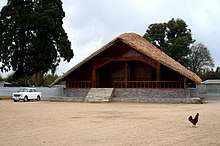
The traditional political structure of the Khasi community is democratic in nature. In the past, the Khasis consisted of independent native states called Syiemships, where male elders of various clans under the leadership of the Chief (called U Syiem) would congregate during Durbars or sessions and come to a decision regarding any dispute or problem that would arise in the Syiemship. At the village level, there exists a similar arrangement where all the residents of the village or town come together under the leadership of an elected Headman (called U Rangbah Shnong), to decide on matters pertaining to the locality. This system of village administration is much like the Panchayati Raj prevalent in most Indian States. There were around 25 independent native states on record which were annexed and acceded to the Indian Union. The Syiems of these native states (called Hima) were traditionally elected by the people or ruling clans of their respective domains. Famous among these Syiemships are Hima Mylliem, Hima Khyrim, Hima Nongkhlaw, amongst others. These Syiemships continue to exist and function till today under the purview of the Khasi Hills Autonomous District Council (KHADC), which draws its legal power and authority from the Sixth Schedule of the Constitution of India.[4]
Religion
Before the arrival of Christian missionaries, the majority of the Khasi people practiced an indigenous tribal religion.[5][6] Though around 85% of the Khasi populace have embraced Christianity, a substantial minority of the Khasi people still follow and practice their age old indigenous religion, which is known as Ka Niam Khasi or Niam tre. The main Christian denominations followed by the Khasis include Catholicism, Anglicanism, Presbyterianism (largest Christian denomination among the Khasis), and others. There are also a small number of Khasis, as a result of inter-community marriages, who are Muslims. There are also followers of Khasi Unitarianism as founded by Hajom Kissor Sing Lyngdoh Nongbri.
Notable people
- U Tirot Sing Syiem, freedom fighter and martyr
- U Kiang Nangbah, freedom fighter and martyr
- George Gilbert Swell, former Deputy Speaker of the Lok Sabha and Ambassador to Norway and Burma
- James Michael Lyngdoh, former Chief Election Commissioner of India
- Keishing Clifford Nongrum, MVC,Mahavir Chakra awardee (Posthumusly)
- Skendrowell Syiemlieh, Notable Khasi folk singer and Padmashree awardee.
- Neil Nongkynrih, director of the Shillong Chamber Choir
- David R. Syiemlieh, former chairman, Union Public Service Commission
See also
- Khasi pine
- Tirot Sing
- Anglo-Khasi War
- Tungrymbai
Notes
References
- "A-11 Individual Scheduled Tribe Primary Census Abstract Data and its Appendix". censusindia.gov.in. Government of India. Retrieved 28 October 2017.
- Shakuntala Banaji (1 April 2010). South Asian media cultures. Anthem Press. pp. 48–. ISBN 978-1-84331-842-2.
- Aurelius Kyrham Nongkinrih (2002). Khasi society of Meghalaya: a sociological understanding. Indus Publishing. pp. 130–131. ISBN 978-81-7387-137-5.
- "Traditional Institutions of the People of Meghalaya, Heritage of Meghalaya: Department of Arts and Culture, Government of Meghalaya". megartsculture.gov.in. Retrieved 13 September 2017.
- Iarington Kharkongngor (1973), The Preparation for the Gospel in Traditional Khasi Belief. I. Kharkongngor. pp. 19-26.
- Gurdon, P.R.T. The Khasis.
Sources
- Chaubey; et al. (2011), "Population Genetic Structure in Indian Austroasiatic Speakers: The Role of Landscape Barriers and Sex-Specific Admixture", Mol Biol Evol, 28 (2): 1013–1024, doi:10.1093/molbev/msq288, PMC 3355372, PMID 20978040
- van Driem, George L. (2007b), Austroasiatic phylogeny and the Austroasiatic homeland in light of recent population genetic studies (PDF)
- Ness, Immanuel (2014), The Global Prehistory of Human Migration, The Global Prehistory of Human Migration
- Zhang; et al. (2015), "Y-chromosome diversity suggests southern origin and Paleolithic backwave migration of Austro-Asiatic speakers from eastern Asia to the Indian subcontinent", Scientific Reports, 5: 15486, Bibcode:2015NatSR...515486Z, doi:10.1038/srep15486, PMC 4611482, PMID 26482917
External links
| Wikimedia Commons has media related to Khasi people. |
- Census of India 2001, Scheduled Tribes
- The Khasis by Gurdon, P. R. T.
- Government of Meghalaya Portal
- Dictionary German Khasi
